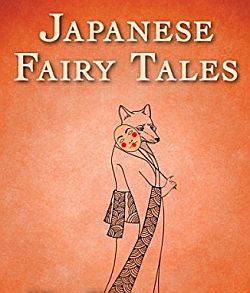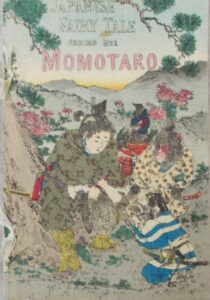 The Japanese Fairy Tales Series was published by Hasegawa Takejiro between 1885 and 1922. Hasegawa combined the talents of well-known traditional Japanese woodblock printers like Kobyashi Eitaku, Suzuki Kason, and Chikanobu, with celebrated foreign translators, creating an enduring international success. Most of Hasegawa’s books were produced in limited amounts, generally four to five hundred at a run, and now have become quite scarce in Japan and internationally. As with most collectible rare books, the earlier editions are the most valuable. Identifying a true first issue of this series is difficult due scarcity and also the combinations of prevalent identifiers which need to be considered: date printed on the copyright page, address of the publisher, composition of the title, material of construction.
The Japanese Fairy Tales Series was published by Hasegawa Takejiro between 1885 and 1922. Hasegawa combined the talents of well-known traditional Japanese woodblock printers like Kobyashi Eitaku, Suzuki Kason, and Chikanobu, with celebrated foreign translators, creating an enduring international success. Most of Hasegawa’s books were produced in limited amounts, generally four to five hundred at a run, and now have become quite scarce in Japan and internationally. As with most collectible rare books, the earlier editions are the most valuable. Identifying a true first issue of this series is difficult due scarcity and also the combinations of prevalent identifiers which need to be considered: date printed on the copyright page, address of the publisher, composition of the title, material of construction.
The original series included 20 volumes published between 1885 and 1892, with another three volumes subsequently published in what is considered the second series. “The Fairy Tale series introduced traditional Japanese folk tales, first to readers of English and French, and later to readers of German, Spanish, Portuguese, Dutch, and Russian,” writes the Public Domain Review’s Christopher DeCou. The English and French translations are the most valuable, which contain the first issues of the first few volumes published with titles written in Romaji (romanized Japanese language), without series volume numbers. Later volumes from the series, as well as all later printings of the first volumes, have titles spelled phonetically in English “englished.”
Possible first issues of the first six titles should have the date 1885 printed. Japanese dates use the era of Japanese history as a starting point with an added offset to specify a date. For example, the year 1885, is printed with the Meiji era (明治) which extended from October 23, 1868, to July 30, 1912. Thus, the year 1885, is printed as (Meiji era with 18 years added: 明治18年), or 18 years after the beginning of the Meiji era (明治十八年). The trailing 年, denotes the year in generic contexts. Therefore, the characters before the year (年) denote the year of publication. A revised edition (再版), published in 1886, has the date printed as (Meiji 19: 明治19年), which corresponds to the Japanese kanji: (明治十九年) .
The colophon has Hasegawa’s address printed which on early appearances shows the Konbusha imprint with the address: “Minami Saegi-cho, Tokyo“, which was the very first address of the publisher. Later addresses include “Maruya-cho”, “Kyobashi-ku,” and more recently, Nihonbashi-honcho, Chuo-ku, Tokyo. Around 1890, the Kobunsha imprint was discontinued and the T. Hasegawa imprint was established.
Most of what is available for sale today, were printed on “Chirimen-bon” (Crepe Paper Books), with color woodblock illustrations and a white string binding. The very first issues of the first few volumes were printed on plain, uncreped paper and hence a bit larger than the creped versions, approximately 18.1 x 12.3 cm. It appears that the shift from the production on plain paper to creped paper books coincided with the establishments of the T. Hasegawa imprint, circa 1890.
The true first issue of the series #1 thru #6 are printed on plain paper, have a transliterated (spelled phonetically in English) title without the “Japanese Fairy Tale Series No. __” subtitle on the front cover or inside the front cover, and have the Konbusha “Minami Saegi-cho” address imprint with the date 1885.
Before becoming collectable, the stories were produced more with the view to interest young readers of the West than collectors of Japanese folk-lore. Children’s rare books are famously scarce simply because children aren’t the best library archivists. Torn pages, broken string bindings, dog-eared edges, corner cuts, stained pages are common features of these books. Coupled with the fragile material of construction, the survival rate for such books is extremely low. They are collectible in any condition. If you find a first issue or close to it with soiling or pages which are worn, don’t wait around for a “better” copy – just grab it and run!



{ 0 comments… add one now }